Francois Gabart and MACIF win Vendee Globe
François Gabart crossed the Vendée Globe finish line at 14:18:40 UTC today, setting a new Vendee Globe and solo round-the-world record of 78 days, 2 hours, 16 minutes and 40 seconds. This beat Michel Desjoyeaux’s record time set during the last Vendee Globe in 2008-9 by 6 day and 53 minutes.
During the race MACIF sailed 28,646.55 miles at an average speed of 15.3 knots (the direct route for the race is theoretically 24,393 miles). This compares with Michel Desjoyeaux's 'real' average speed of 14.02 knots, Foncia having sailed 28,303 miles.
Aged 29, Gabart becomes the youngest winner in the history of the Vendée Globe. He remained in the lead of the race for 45 days and 23 hours, ie nearly two thirds of the race and set six records. Among them was the impressive record of sailing 534 miles in 24 hours (averaging 22.27 knots), the result of the astounding match race from beginning to end with Armel Le Cléac’h and Banque Populaire.
On his arrival Gabart commented: “It is a huge relief! To the end, you never know what can happen, particularly since the last night was not so easy. For several days I had begun to believe in it nonetheless! We have super boats! As I left, I didn’t think I would be coming back victorious. But in the Indian Ocean I started to believe it was possible. It is a difficult race, but I tried to fight it with equal temperament. I never bowed my head nor gave up, or at least only for a few seconds… Five days after the start, I had a small problem with the engine. It was a little rough, but I managed to fix it. The hardest of all is the length and the constant pace! It never stops! Even in the Bay of Biscay, I was not spared! It’s the calm that I missed most, since we were tossed about a lot - something that doesn’t move anymore - and then of course, my friends, my girlfriend, my son, the life of a landlubber! Thank you Armel Le Cléac’h. What we experienced together was exceptional! For the racers we are, to experience such a confrontation from the inside is a privilege.”
Gerard Andreck, Chairman of the Groupe MACIF, sponsors of François Gabart since 2009 added: ‘‘Some adventures can sometimes exceed our most insane dreams and this is the case with François. We knew that we had discovered gold and that his talent had all the qualities for great achievements, but we never considered such a result, which resounds well beyond the sports result. François has this fascinating ability to federate and conquer everyone around him. It is an astonishing charisma and it is difficult not to fall under his spell. You cannot imagine just how much, even at sea, he was available for the workers of MACIF and the number of people who share his joy today.”
Key figures
Longest distance covered in 24 hours: 10 December, 545 miles at an average speed of 22.7 knots.
Days spent leading the race: 44 days 20 hours
Les Sables to Equator: 11 days 00 hours 20 min (Jean Le Cam’s 2004-2005 record: 10 days 11 hours 28 min)
Equator to Good Hope: 12 days 03 hours 25 min (JP Dick’s record: 12 day 02 hour 40min)
Good Hope to Cape Leeuwin: 11 days 06 hours 40 min (new record)
Cape Leeuwin to Cape Horn: 17 days 18 h 35mn (new record)
Cape Horn to Equator: 13 days 19 hours
Equator to Les Sables: 12 days 01 hour 37 minutes
While he had a new latest generation VPLP-Verdier designed IMOCA 60, Gabart started the race as an outside hope this being his first Vendee Globe, compared to the wealth of experience of his rivals, such as Vincent Riou, Jean-Pierre Dick and Armel le Cleac'h.
Here's how Gabart and MACIF's race panned out:
Saturday, 10 September: First to lead!
On the Port Olona pontoon, when people were saying their last goodbyes, François was in such a hurry to do battle that he was OCS and had to turn round and cross the line again. This was not a problem. In the 20:00 sched, MACIF was already leading the Vendée Globe and François posted his first video, still in a state of shock from the start and his sail down Les Sables channel, surrounded by the thousands of supporters who had come to see off the 20 sailors of this seventh Vendée Globe: “Wow! What a moment THE start of the Vendée Globe is! :-) It’s indescribable; such are the feelings and sensations! The magic worked. I’m still utterly astounded.” In reference to his early start, he added: “A start a little too early is normal, it’s a regatta! It’s not very serious. You go back immediately and it’s off again. There’s still a long way to go.”
Monday, 12 November: “For once in my life, I have led the Vendée Globe!”
Still in command of the race as he passed Cape Finisterre and was sailing off Lisbon, François really enjoyed his first days on board MACIF, after a night's rest at last. “I am very satisfied. You could not imagine a better start to the Vendée Globe. The start isn’t the most important thing, but it’s good to begin this way. I do not know what will happen next, but at least I can say that for once in my life, I have led the Vendée Globe.”
Friday, 16 November: “Long live Niort!”
It was the end of the first week of racing on board MACIF and François Gabart was sailing alongside his friend from 'Niort, Bernard Stamm [Cheminées Poujoulat and MACIF are two companies located in Niort] as they continued their run down the Atlantic. This is what he had to say about this: “The Mayor of Niort must be happy to see his two protégés side by side in the middle of the Atlantic. Both on the podium. Long live Niort and the people of Niort!” In relation to his good first week spent in the top three, François does not deny himself any pleasure: “There were errors to be made that I knew how to avoid. I am delighted and pleasantly surprised by the start of this race. I never expected to be able to say at the start that I would be in the lead in the first days of racing, but it’s very rewarding!”
Wednesday, 21 November: Upside down
After 11 days and 9 minutes of racing, MACIF crossed the equator in second position, 4 hours and 41 minutes behind the leader, Banque Populaire. Jean Le Cam’s record at the equator, dating back to the Vendée Globe 2004-05, was not broken. Back then sailing on Bonduelle, it took le Cam 10 days, 11 hours and 22 minutes to cross to the south. As the fleet left the Doldrums they group, and François sent the following message on the morning of 21 November: “Yesterday morning, coming out of the Doldrums, five of the boats could see each other! Since the start, the number of times I have not had at least one friend on the AIS have been rare! So much the better, this means that the race is keeping all its promises, it’s a fine regatta.”
Friday, 23 November: Memories of Brazil
End of the second week of racing for MACIF, now sailing off the coast of Brazil, in second place, 50 miles behind Banque Populaire. François, who was desperately looking for a place to shelter on board from the intense sun, remembered his previous passage along the coast of Brazil, with Michel Desjoyeaux in the Barcelona World Race: “I was thinking of the Barcelona race yesterday. I was saying to myself that the boat on which we were is in the lead (Banque Populaire was formerly Foncia 2 sailed by Michel Desjoyeaux), and that the one we built since then is in second position in a rough sea, about 50 miles behind. It is very rewarding to know that we did good work on these boats, even though the race is far from over. I think that I am one of the skippers who has made a lot of progress in two years and that's a good thing.”
Tuesday, 27 November: Option at St Helena
It was option time for François! To get around the St Helena anticyclone he decided to distance himself from the shortest route, taken by Armel Le Cléac'h, by setting a southward course in search of the first low pressure areas of the Great South. A choice made beforehand by Jean-Pierre Dick who bet on a long loop to the west. Later, François said: “I am satisfied, because I don’t know what the result would have been if I’d stayed behind Armel. Since I was 50 miles behind him, I'm not sure I would have got through as easily as him.”
Friday, 30 November: First record and the Roaring Forties
As he entered the Roaring Forties, François managed his first record at the helm of MACIF, covering 474.5 and then 482.91 miles sailed in 24 hours, or almost 15 miles faster than the record of 468.72 miles set by Alex Thomson in 2003 during the Atlantic Challenge. A little later in the day, Jean-Pierre Dick elevated this record still further to 502.53 miles. The heat of South America was now behind MACIF and François was beginning to feel the first signs of the Great South. “It’s starting to look like it, with good surfing conditions, a sea that is getting rough, stronger wind and quite a few birds having fun soaring behind us. These are not yet the albatrosses. I think they are more like petrels. So for the moment, it is more like a 'mini South' with 'mini birds' instead of albatrosses, 'mini waves' instead of big waves and as far as the wind is concerned, it's more around 25-30 knots than 40-45, sometimes even 50 that we will probably have later.”
Sunday, 2 December: Indian Ocean and memories of dismasting
Although Armel Le Cléac'h was the first to pass the Cape of Good Hope after 22 days, 23 hours and 48 minutes, beating the reference time, previously set by Vincent Riou and PRB in 2004 (24 days, 2 hours and 18 minutes), MACIF entered the Indian Ocean in the lead, south of Cape Agulhas, whose longitude he crossed the same day at 19:01 UTC, a quarter of an hour and a half hour ahead of Dick and Le Cléac'h.
For François, this passage round South Africa brought back some bad memories: “In a few minutes I will sail by a specific point. It is called the 'Barcelona World Race 2010 dismasting'. No need to explain, you understood. As if by fate, my route runs right by it, a few nautical miles from the place where the race came to an end for Michel Desjoyeaux and myself. Perhaps it is to reflect on or ward off ill fortune and say ‘this time I’m sailing past and this time I’m not stopping’. The circumstances are similar. Full speed, ahead of the front, starboard tack, alongside 'the Smurfs' (Virbac-Paprec 3 sailed by Jean-Pierre Dick and Loïck Peyron in the Barcelona World Race). I decided that it would be different and I prepared myself so that it would be different. I sailed so that it would be different. The whole team has worked hard for two years to make it different.”
Thursday, 6 December: The real Indian Ocean!
A week after talking about a 'Mini Indian', by now conditions were getting difficult. “For the moment, I am getting the South Indian. The Indian Ocean was always described to me as an area in which there are fairly violent phenomena and a particularly difficult sea. I have had my fair share! These last days, the sea was not very bad, but, on the other hand the waves were fairly steep. This was not very pleasant for MACIF, or for her skipper. In these conditions, you need to watch out, because it’s particularly uncomfortable and even dangerous. The sudden blows to the boat stop you in your tracks and are very strong.”
From a strategic point of view, although Armel Le Cléac'h decided to sail past the west end of the Crozet gate, François, as well as Jean-Pierre Dick, Bernard Stamm and Alex Thomson, together chose to pass the east end. “It was not an easy decision to make. I chose the strategy that looked to be the least risky. The second element that dictated my choice was that there is quite a lot of ice in the south and the optimal routes, when cutting through the gate in its first part, would oblige you to go very far south to look for the wind to the north of the Crozet islands, which are littered with ice, whereas the eastern route brings us into areas with no icebergs. This was what won me over. I didn’t want to go playing about in the middle of the icebergs.”
Friday, 7 December: MACIF at Crozet
MACIF crossed the Crozet Gate at 23:46 (UTC), the first in the Indian Ocean, without any fanfare for François who notes jokingly that he is very much alone at sea: “We did not see anybody. Neither the public, nor the organisation for a clock in. That said, it was still night... The day is breaking now with the beautiful MACIF pointing her bow back to the South. Albatrosses, here we are!” And to conclude his message of the day: “François, now that his boat is heading in the right direction and in principle well set, will now go and get some well-earned sleep.”
Monday, 10 December: Fast and Furious!
Ten days after having relieved Alex Thomson of the 24 hour record, François Gabart pocketing a new record, that is to say 545.3 miles between Sunday 9 and Monday 10 December (16:00 ranking) at an average speed of 21.1 knots (although the WSSRC later confirmed the record at 534.48 miles at an average of 22.27 knots). Therefore MACIF pulverised the record established by Jean-Pierre Dick ten days earlier of 502.53 miles. He even bettered the record set doublehanded by Jean-Pierre Dick and Loïck Peyron, during the Barcelona World Race of 516 miles.
What do you feel this? “Adrenalin and excitement. For a guy like me, who wants to make headway with his boat as quickly as possible, it’s really nice to have averages that flirt with 25 knots for a few hours, particularly when you feel that the boat is well balanced and not been forced too much. This harmony is a very pleasant experience. However another part of the sailor has his teeth gritted a little, doubting and being wary.”
François also took the lead again, at the expense of Armel Le Cléac'h, delivering at the same time a quick explanation on the speed difference between the duo: “I’ve nothing to hide, I have a sail, which he doesn’t and this helps MACIF make progress in the right direction.” The sail in question is a 'reacher' which, in a strong following wind, enables him to maintain high average speeds. “By using this in the South, it means I do not damage the flat sails that I intend to use as I sail back up the Atlantic, i.e. the solent and staysail (or J1 and J2).”
Tuesday, 11 December: “At the Amsterdam gate”
The day after his 24-hour record, François crossed the Amsterdam gate at 1:42 UTC, 17 minutes before Armel Le Cléac'h.
Saturday, 15 December: Cape Leeuwin and two more records!
11 days, 6 hours and 40 minutes after having rounded the Cape of Good Hope and after 34 days, 10 hours and 23 minutes at sea, François crossed the longitude of the second of the three legendary capes of Vendee Globe leading; Cape Leeuwin, beating two records in one blow - that of Vincent Riou on the Les Sables-Cap Leeuwin section (36 days and 12’48” in 2004) and that of Michel Desjoyeaux between th Cape of Good Hope and Cape Leeuwin (11 days and 06’49” in 2008). “Cape Leeuwin means that the Indian Ocean is over, part of the course is finished. It went well, since MACIF is in a good position. I am now going to be south of Australia, in a different area from a weather point of view, with the Pacific part of the race opening ahead of me.”
Tuesday, 18 December: Storming the Pacific
Always in close quarters with Armel Le Cléac'h, François attacks the Pacific without any particular apprehension, and even finding time passing quickly: “I am really happy to be here. I'm not feeling weary, on the contrary. During the first days of the Vendée Globe, I found it difficult to plan ahead. Ahead of me was too huge to try and imagine anything: 24,000 miles, three months seemed colossal and I had no references to go on. But since then, I feel that I'm in command of time. I don’t feel this completely legitimate fear anymore in relation to the length of the race. I even get the impression that it’s fast!”
Thursday, 20 December: On the way back
As he moved into the difficult weather conditions below Auckland Island, south of New Zealand, François had reached the half-way mark, after 40 days at sea. This was psychological hurdle to which he was not insensitive: “It is certainly symbolic, but it is a pleasant feeling to be able to say that the quickest route home lies ahead of me. We will try to do as well or better in the second half. I am really glad to be at sea, to be experiencing this. It is not easy every day, but I try to make the most of it since these are exceptional moments.”
Tuesday, 25 December: “Happy Christmas!”
45th day of racing and a first Vendée Globe Christmas for François. “Merry Christmas everyone. I still have the wind. I’m being tossed about a bit, but I’m running fast and in the right direction, so there’s nothing to complain about. I am 7-8 days from Cape Horn.”
Saturday, 29 December: Last gate and duel on film
On 29 December at 07:45 UT, Francois, followed ten minutes later by Armel Le Cléac'h passed the last of the Vendée Globe’s ice gates. MACIF and Banque Populaire were sailing within sight of each other, each skipper taking advantage to send a film of his neighbour. On his, François commented: “We have sailed about 15,000 miles, and as you can see, it’s hard to get away from Banque Populaire. We’re sailing at really close quarters, ten lengths from one another. It's totally amazing. It is as though Usain Bolt won the 100 metres with a 1 millimetre lead! But I’m really enjoying it.”
Tuesday, 1 January: François the Cape Horner!
He did it. In difficult conditions ahead of a front that was following him, François Gabart rounded Cape Horn in the lead on this first day of 2013. At 18:20 UTC, after 52 days, 6 hours and 18 minutes of racing - a new reference time. He improved on the time of 4 days, 8 hours and 50 minutes set by Michel Desjoyeaux four years earlier and clocked a 1 hour and 15 minutes lead over Armel Le Cléac'h as they left the Pacific. Although he could not comment on his first Horn live, due to very poor visibility and particularly difficult weather conditions, François told of his emotion the following day: “I passed 2.5 miles from Cape Horn. At first, I did not see it at all. I ended up seeing a bit of land to the bow, when night fell. Inevitably, the first time does something to you. I hope the next ones will be as intense”.
Thursday, 3 January: The Atlantic in the lead
François Gabart remains in the lead of the Vendée Globe ahead of Armel Le Cléac'h, who ended up giving him the slip towards the end of the Pacific. Questioned on the small gap widening between them at this time, he commented: “You had to go fast under gennaker; perhaps Armel didn’t have the same sail as I did. Since the beginning of the race, MACIF has been rather fast in these conditions, so I’m not particularly surprised. However, on the scale of what remains to be sailed from here to Les Sables d’Olonne, it’s not very much.”
Monday, 7 January: More often ahead than not!
In the lead at 05:00, François overtook Armel Le Cléac'h in the amount of times he had spent in first out in the five daily scheds. He counts 138 positions as leader against his rival’s 137. Off the South American coast, the duel continues between MACIF and Banque Populaire, making François say: “Our routes converge. Like a good old couple, we always find each other.” Not for much longer.
Friday, 11 January: The decisive gap
First ranking on this morning of Friday, 11 January, and the distance separating François from Armel Le Cléac'h had increased to 130 miles, against 60, four days earlier. “It is always good to actually see this. It’s always enjoyable to gain a little. It’s no luxury.”
This gap continued to increase until the Doldrums, culminating at 274 miles on Monday, 14 January at 16:00, when MACIF was at 5°S. Francois explained: “Since the Falklands, I was a little further to the east than Armel, because I didn’t want to get too close to the small lows that form constantly in and around Cabo Frio (west of Rio). To approach this area, there are several options. Either you head completely to the east to get away from the influence of these lows, or you head completely west along the South American coasts to try and pass these lows to the west downwind, or you gamble on routes in the middle, which is what Armel and I have done. As I was sufficiently out to the east, I was able to get away, while Armel got stuck inside, which quickly resulted in widening the gap.”
Tuesday, 15 January: Back to the North
A little under 55 days after having sailed into the southern hemisphere, François crossed the Equator in the opposite direction, at 13:41 UTC, setting a new reference time of 66 days, 1 hour and 39 minutes, or 5 days, 15 hours and 33 minutes ahead of Michel Desjoyeaux's time in the last Vendée Globe. His lead over Banque Populaire, with just 3,200 miles to go to the finish in Les Sables d’Olonne is 15 hours and 6 minutes.
Friday, 18 January: Attacking the Azores
As on the way out, François experience a difficult Doldrums, which gave Armel Le Cléac'h behind him a chance to reduce the distance by about 100 miles, as they departed it. “Between the outward and return trips, I can’t be far from beating the record for difficulties met in the Doldrums! I had the traditional squalls with a wind changing from 5 to 40 knots in five minutes, but above all, I had very light wind very early, contrary to Armel. At 3°S, I was only making 10-12 knots, when Armel, a few hours later in the same place was making 15-16 knots. I lost a great deal over this period.”
For all that, there was no question of self-pity. He tackled the last major hurdle of the course, the Azores anticyclone, with a double goal: “For a few days, when I take stock of the weather, I systematically check the routing for myself and Banque Populaire, to see which route in principle Armel will follow, and adapt mine consequently. I’m not about to start creating huge lateral distances. That would be stupid.” Does he think of winning? “Maybe once a day, but I still think more of finishing than winning.”
Monday, 20 January: “I am trying to go as quickly as possible!”
François has set himself a strategy for the last days of racing: run round the Azores high by the west and key into the depression coming across the North Atlantic to head directly to Les Sables d’Olonne in conditions that are looking rough in the Bay of Biscay. “I’m in a hurry to get back home despite the cold in France. I think that I’m going to enjoy returning to a more normal life. I’m going to have to continue to remain focussed until the end, but I’m prepared for that so it should go well.”
Wednesday, 22 January: “On the right side of the anticyclone”
The last major weather obstacle of the Vendée Globe, the Azores high is virtually behind François who has just finished going round it. “The wind is returning for me. I think that I am on the right side of the anticyclone”, he observed at lunchtime. “I’m setting a course for France as quickly as possible. The sea is virtually flat. I am downwind under spinnaker with 15-17 knots. There is still sunshine and the weather conditions are perfect.”
Naturally, the skipper is greatly relieved to get out of this anticyclone unscathed. He was apprehensive about it and quite worried about it ten days earlier: “I lost a little at the start, but we still had pressure in the anticyclone. Armel never went below a speed of 14-15 knots, which enabled him to shorten his route a little in comparison with mine. I must have lost 20 or 30 miles because of this, but it is less than I feared ten days ago.”
Friday, 24 January: 48 hours under pressure
More than 800 miles to go for François, who still holds a 100 mile lead on Armel Le Cléac'h. Enough to feel the weight of the pressure of Banque Populaire’s skipper on his shoulders? “I don’t necessarily feel it in relation to him, but I am under pressure, because there are 800 miles to go and they are not looking very easy. If Armel was 800 miles behind, naturally, I would feel less pressure. I have a 100 mile lead. It is both a lot, because it represents more than 10% of the distance left to sail, and not enough, if something should happen and I need to take the day to repair. 100 miles at our current speed, that means 7-8 hours, is not much.”
For François, getting distracted by the approaching finish line and the festivities ashore is out of the question. The skipper has one thing in mind, making progress with MACIF in the right direction while remaining ever vigilant: “I am making sure that I take no risks, as much in relation to piloting the boat as in terms of strategy. I am trying to get myself into a position which, no matter what the unforeseeable weather conditions are, will always give me a slight advantage on Banque Populaire.”

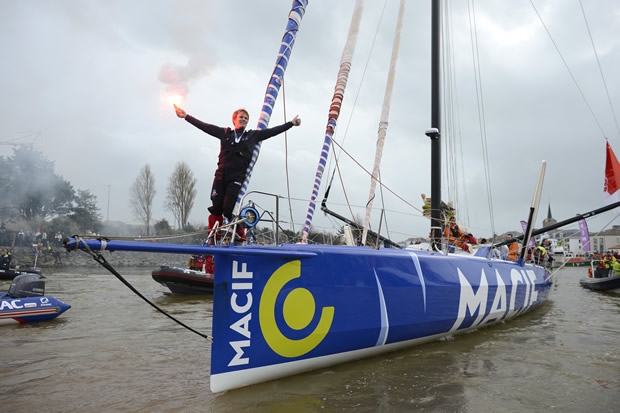
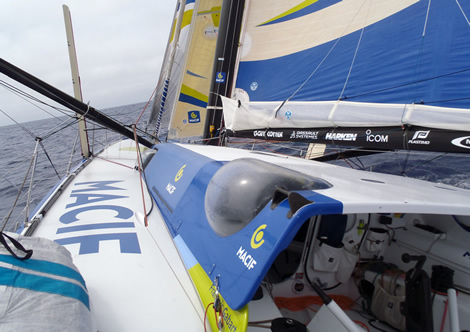
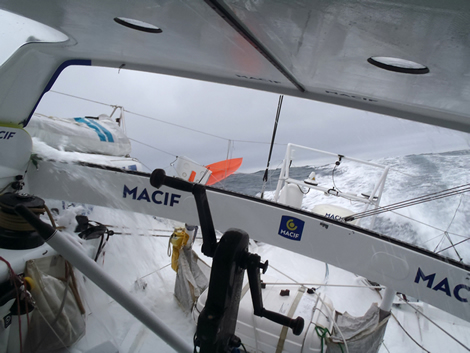
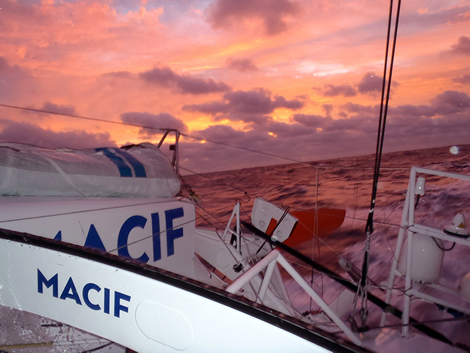
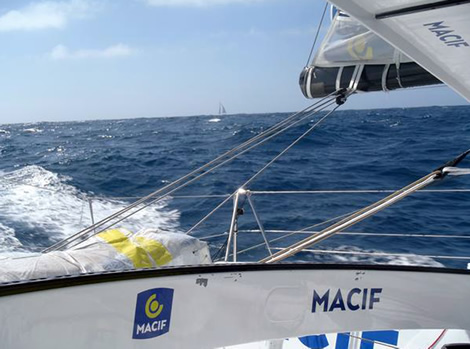
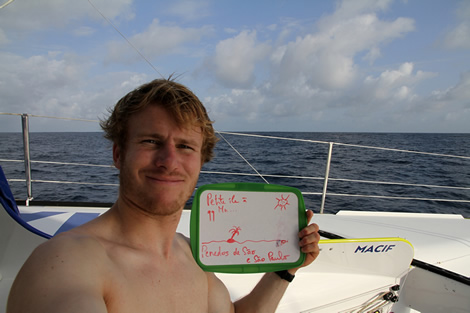
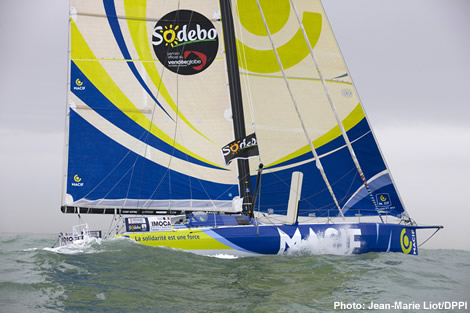
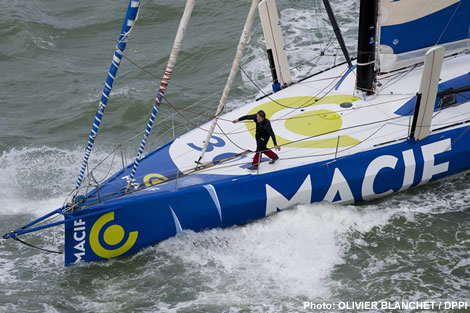
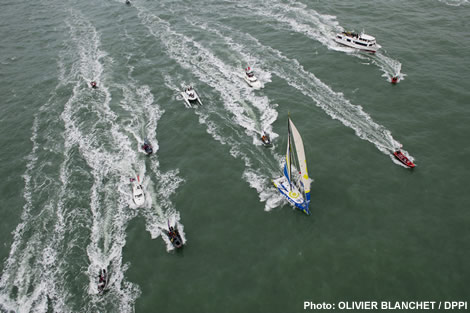
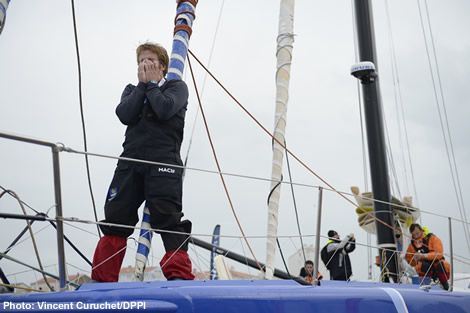
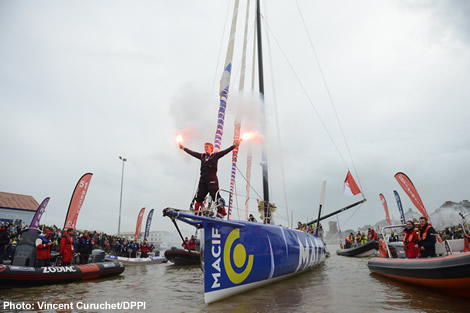
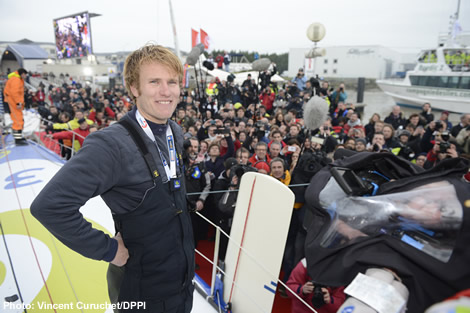
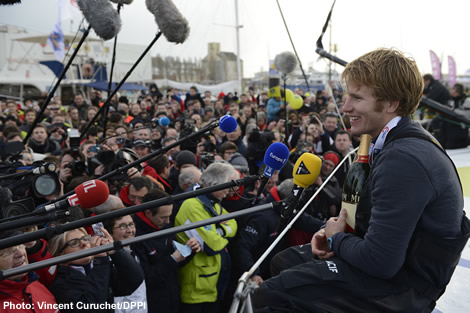









Latest Comments
Peter Carp 28/01/2013 - 08:14
excellent summery of a fantastic race, a new sailing star is born...peterMerfyn Owen 27/01/2013 - 21:08
The fourth from bottom pic. is a classic - what an amazing performance. What do you do after this when you're only 29?
381394 27/01/2013 - 18:02
Thanks for collating the above and for your coverage and comments on this brilliant race James.Add a comment - Members log in